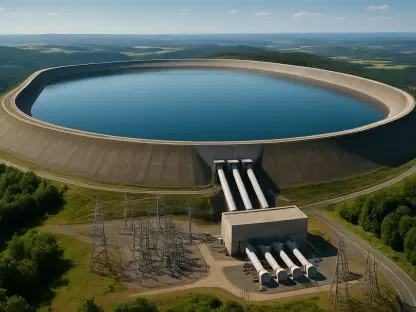The recent advancements in AI technology by the Chinese startup DeepSeek have sent shockwaves through the energy and technology sectors. The company’s breakthrough in creating highly efficient AI models at a fraction of the cost of leading U.S. products has led to a significant reevaluation of future electric demand projections. This development has had immediate repercussions on the stock prices of independent power producers, particularly those with substantial nuclear and gas generation assets.
The Market Reaction
Stock Price Declines
On Monday, shares of several independent power producers plummeted amidst a broader selloff in technology and AI infrastructure stocks. Companies like Vistra Corp., Talen Energy, and Constellation Energy saw their stock prices drop by over 21%. This decline was triggered by DeepSeek’s recent achievement, which showcased two high-performing AI models that are significantly more cost-effective than those from U.S. tech giants like OpenAI and Anthropic. The rapid adoption of DeepSeek’s AI assistant, which quickly became Apple’s most-downloaded free app, further fueled market concerns. As the news spread, it became clear that the advancements made by DeepSeek could potentially reshape the future landscape of AI technology, creating ripples throughout the energy sector.
The event has clearly cast doubt on the previously bullish projections for U.S. electric demand, which were heavily influenced by anticipated growth in AI infrastructure. According to investment bank Jefferies, AI was expected to account for about 75% of overall U.S. demand forecasts through 2030-2035. The dramatic efficiency gains demonstrated by DeepSeek’s AI models suggest that future AI performance improvements might require significantly less energy than previously anticipated. This revelation could destabilize the carefully laid out plans and expectations of various stakeholders within the energy market who had projected extensive data center growth and the subsequent increase in electricity consumption.
Impact on Power Producers
Reassessing Investment Theses
The newfound efficiency in AI technology has led to a reevaluation of investment theses for independent power producers and integrated utilities. These companies had been relying on robust data center growth to justify future generation capacity expansions. For instance, Jefferies highlighted that the economic basis for Constellation’s $274 stock price target was largely dependent on extensive and lucrative data center contracts for nuclear power. These projections had been cornerstones for securing investor confidence and justifying substantial capital expenditures aimed at ramping up power generation capabilities.
Utilities’ expected gains are intricately tied to increasing the rate base, driven by new generation needs prompted by data centers. A slowdown in these projections would negatively affect utilities perceived to have high rate base growth potential. Analysts suggest that Talen Energy might be better positioned under a reduced demand scenario due to its less aggressive data center contraction assumptions and existing contracts with Amazon involving the Susquehanna nuclear generating station. This insight hints at a cautious yet strategic positioning for certain power producers who might weather the storm of altered demand projections more adeptly than others, primarily hinging on their diversified portfolios and pre-existing contracts.
DeepSeek’s Market Impact
Potential for Increased AI Adoption
Some analysts argue that DeepSeek’s breakthrough in low-cost AI models could actually drive demand for AI infrastructure by speeding up adoption rates among consumers and firms. This perspective leans on the Jevons Paradox, wherein increased efficiency results in higher resource consumption. J.P. Morgan envisions that lower AI costs could catalyze widespread adoption, resulting in greater demand potentially. This seems plausible, given that more affordable AI solutions would be accessible to a broader market, spurring innovation and further investments into the AI sector by companies eager to capitalize on the technology.
Moreover, as AI becomes more integrated into everyday business operations and consumer products due to lowered costs, the overall demand for supporting infrastructure could experience a boomerang effect leading to elevated levels of energy consumption despite initial efficiency gains. This ironic twist, predicated on historical examples of technological adoption patterns, underscores a potential scenario where resource demands could surge rather than abate as AI becomes more prevalent. Although this perspective remains speculative, it adds a layer of complexity to the ongoing discussion regarding the trajectory of energy requirements and the role of AI.
The Stargate Joint Venture
A significant development likely to shape future power demand is the AI joint venture called Stargate, promoted by President Donald Trump. This venture includes investments from OpenAI, Oracle, and SoftBank, amounting to $500 billion directed towards enhancing U.S. data centers. Trump has proposed “clean coal” as a power source for this initiative, which could have substantial implications for future energy demand. The initiative is poised to supersize the existing paradigms for data center growth by leveraging immense financial resources coupled with cutting-edge technological advancements.
Should the Stargate venture succeed in its objectives, it will likely project a renewed surge in demand for energy resources tailored to AI infrastructure. This bold endeavor could, in essence, turn the tables on the anticipated downturn in energy demand by drawing upon deep financial wells and pioneering technologies. On the flip side, the reliance on “clean coal” as a power source presents its own set of challenges and criticisms, especially in terms of environmental sustainability and long-term feasibility. However, the sheer magnitude of the investment involved indicates a decisive push towards aggressive data center expansion, potentially mitigating some of the contraction risks flagged by DeepSeek’s model efficiencies.
Future Projections and Technological Shifts
Escalating Load Growth Projections
Recent energy demand forecasts suggest significant rises in load growth. For instance, the PJM Interconnection, which contains a high proportion of data center capacity, recorded forecasted peak load growth rates showing summer and winter peak loads with average annual increases of 2% and 3.2%, respectively, until 2045. These projections were based on the assumption of continued robust growth in AI infrastructure. Such insights underscore the interdependency between burgeoning AI technology and the expanding energy footprint it necessitates, feeding into the broader narrative of planned capacity expansions and rate base increments within the utilities segment.
However, such assumptions may need to be revisited in light of recent technical efficiencies demonstrated by DeepSeek. The pronounced juxtaposition between anticipated demand growth and potential efficiency-driven contractions presents a conundrum for energy planners and investors alike. Revisiting these projections could usher in a wave of recalibrations affecting everything from capital funding to strategic alliances and infrastructure planning, essentially reshaping the contours of the energy demand landscape based on a shifting technological backdrop.
Potential Contractions in Demand
The latest strides in AI technology made by Chinese startup DeepSeek have created a stir in both the energy and tech sectors. DeepSeek’s groundbreaking achievement in developing highly efficient AI models at a fraction of the cost compared to leading U.S. products has prompted significant reconsiderations of future electricity demand forecasts. This new development has caused immediate shifts in the stock market, particularly impacting independent power producers who possess substantial nuclear and gas generation assets. Investors are reacting swiftly as the traditional dynamics of power production are being reevaluated in light of these cost-effective AI technologies. This could potentially revolutionize the industry by reducing operational costs and increasing efficiency. Furthermore, industries relying heavily on energy may also benefit from lower costs, thus promoting broader economic impacts. As DeepSeek continues to push the envelope, the traditional energy market, especially those reliant on nuclear and gas power, will need to adapt to remain competitive in this rapidly evolving landscape.









